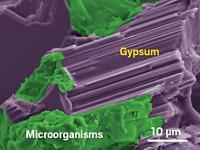Advertisement
Grab your lab coat. Let's get started
Welcome!
Welcome!
Create an account below to get 6 C&EN articles per month, receive newsletters and more - all free.
It seems this is your first time logging in online. Please enter the following information to continue.
As an ACS member you automatically get access to this site. All we need is few more details to create your reading experience.
Not you? Sign in with a different account.
Not you? Sign in with a different account.
ERROR 1
ERROR 1
ERROR 2
ERROR 2
ERROR 2
ERROR 2
ERROR 2
Password and Confirm password must match.
If you have an ACS member number, please enter it here so we can link this account to your membership. (optional)
ERROR 2
ACS values your privacy. By submitting your information, you are gaining access to C&EN and subscribing to our weekly newsletter. We use the information you provide to make your reading experience better, and we will never sell your data to third party members.
Environment
Bacteria In Clouds
Microbial meteorologists investigate how airborne microbes might influence weather
by Sarah Everts
April 14, 2008
| A version of this story appeared in
Volume 86, Issue 15

Ten bucks says that the last time you looked up at the sky on an overcast day, musings about the behavior of bacteria in the clouds did not flit across your mind. Many of us think of the sky as an evolving mixture of inanimate entities: water vapor, nitrogen, oxygen, ozone, aerosols, polluting particles, and increasingly, carbon dioxide.

But a more comprehensive list would include pollen, algae, dandruff, and bacteria. On average, these so-called biogenic aerosols, which are swept up into the atmosphere by wind, account for about 20%, by mass, of the particulate matter in the sky. In the air above tropical rainforests, that figure can be as much as 75%.
"When you unravel the chemical composition of the atmosphere, you quickly find that there are a lot of biological particles up there," says Ulrich Pöschl, an atmospheric scientist at the Max Planck Institute for Chemistry in Mainz, Germany.
Although microbiologists have long known that bacteria float about in the sky—more than 4 miles from Earth's surface—the bugs were seen simply as "severely stressed-out passive passengers" in the air, accidentally windswept out of their more surface-bound niches, says Cindy E. Morris, a microbiologist at France's National Institute of Agronomic Research, in Montfavet.
After all, our blue sky can be a pretty harsh environment: It's cold. There are oxidants. And there is intense ultraviolet light that can wreck the heartiest of genomes. Worst of all, the sky is a dry, desiccating place for biological cells.
But bacteria are resilient: They are famous for eking out an existence in extreme habitats. Think ice, the plaque on your teeth, deep ocean thermal vents, even airplane fuel tanks. Why not the atmosphere?
It is only recently that scientists have begun to think that bacteria, in particular, may not be up there just for the ride. In 2006, the first workshop on microbial meteorology was held in France, and the community has been growing since then, Morris says. She estimates there are between 30 and 50 labs around the world investigating this topic.
These researchers are providing growing evidence that in the wet oasis of the clouds, where bacteria can at least remain hydrated, the microbes aren't just loitering—they're getting down to business.
For example, bacteria in clouds are using the energy stored in adenosine triphosphate to take care of their biochemical needs. Bacteria have been caught breaking down airborne carbon compounds, including organic aerosols. This observation begs the questions: Is the metabolic life of bacteria playing a role in atmospheric chemistry? Can this airborne microbial population act as a carbon sink or source? Do the bacteria degrade pollution?
Even more tantalizing, the bacterium called Pseudomonas syringae, which is found regularly in clouds, has proteins on its cell surface that can nucleate the formation of ice, the precursor to most forms of precipitation. Some atmospheric scientists are starting to wonder if P. syringae and other bacteria in the air may influence weather by initiating rain and snow.
A recent Science paper whetted the palates of many cloud microbiologists by revealing that ice-nucleating biological particles such as bacteria are ubiquitous in snowfalls from all around the world (2008, 319, 1214).
One of the authors, Brent C. Christner, a microbiologist at Louisiana State University, says he's excited about the data. But he acknowledges that it's one thing to find cloud-living, ice-nucleating bacteria in snowfalls; it's another thing to say conclusively that the bugs initiated the snowfall.
"Just because you can culture bacteria from snow doesn't mean they actually caused the snowfall," he adds. "I'd like to think so, but the proof isn't there yet.
"It's like sifting through the ashes of a major blaze, finding a lighter in the rubble, and saying, 'Aha! This is the cause of the blaze.' "
But catching bacteria in the act of ice-nucleation, at altitude, in situ, is exactly what Christner, Morris, and others in the field are hoping to do.
On Earth P. syringae is a plant pathogen that lives on the surfaces of a wide variety of foliage—from tea plant leaves in Zimbabwe to corn stalks in the U.S. The microbe uses its ice-nucleation skills to freeze water on these leaves. Specifically, P. syringae can catalyze the formation of frost at -2°C, whereas pure water on a leaf surface doesn't spontaneously freeze before the temperature drops to several tens of degrees below 0 °C.
The frost causes the plant cells to burst, allowing the pathogenic bacterium to gain entry and infect the plant or its fruit, explains Steve Lindow, a plant microbiologist at the University of California, Berkeley.
Besides its role in infection, some researchers are now asking if the bacterium's ice-nucleating ability helps P. syringae orchestrate its own redistribution by paving a way back down to Earth after it has been swept up into the sky.
"The speculation is that ice nucleation leading to precipitation could be a 'do-it-yourself' landing strategy for bacteria, rather than passively waiting for precipitation to form around them," Pöschl explains.
"It's amazing to think that bacteria might have evolved a way to remove themselves from the atmosphere," Christner adds.
The bacterium's ice-nucleating machinery is a colossal 180-kilodalton protein that has a bizarre repetitive motif, Lindow says. The bulk of the protein is composed of up to 60 repetitions of a 48-amino acid unit. Scientists suspect the majority of the protein rests on the bacterium's outer membrane, anchored there by sections of the protein that dip deep into the lipid bilayer.
No one has yet determined a three-dimensional structure of this protein. Its mammoth size and membrane anchors have made it impossible to crystallize for structural studies. However, several protein-folding simulations suggest the final form includes a lot of b-strand secondary structures that could provide a platform conducive to ice nucleation, says Andrey Kajava, a staff scientist at the Research Center for Macromolecular Biochemistry, in Montpellier, France.
The amino acids most important to the protein's ice-nucleating ability are thought to be serine and threonine residues. Both amino acids are plentiful in the protein and easily form hydrogen bonds with water. Models suggest that a plane of these serine and threonine side chains form hydrogen bonds with water in the same orientation and distance as do water molecules in an ice crystal. So as soon as the temperature dips below zero, the water molecules on and near the surface are already conveniently aligned to form ice.
The protein is such a successful ice nucleator that when it was first discovered in the 1970s, a company formed to sell freeze-dried P. syringae to the artificial snow industry. The bacterial powder, sold as Snomax, is commonly added to the water that ends up as snow on ski slopes.
P. syringae is also rapidly becoming a cloud microbiologist's "model organism"—like the mouse of the medical science community. But many other microbes can subsist in the sky, with a variety of survival strategies. Bacteria such as Bacillus and fungi such as Cladosporium retreat into spores for air travel. Other frequent flyers produce a selection of protective pigments like carotenoids or chlorophylls that can absorb UV light, or they employ enzymes such as superoxidases to cope with the atmosphere's oxidative conditions.
Many in the burgeoning meteorological microbiology field have pondered whether it is a matter of time before they will identify bacteria that choose clouds as their preferred niche and don't just travel intermittently into the sky. But even the most enthusiastic proponents of cloud microbiology say the sky is probably not a niche. "Bacteria can hang on to life in a cloud. But just barely," Morris says. Cold temperatures, in particular, would prevent the growth kinetics one would expect in a niche. The lack of abundant food in the sky further slows growth kinetics, Morris adds.
Although the presence of living bacteria in clouds is broadly accepted, there are some who aren't convinced they play an important role in precipitation. When in situ mass spectrometry is used to detect ice-nucleating particles in clouds, bacteria comprise only 1 to 10%, says Daniel Cziczo, an atmospheric scientist at Pacific Northwest National Laboratory. He says mineral dusts are much more abundant and probably play a more dominant role in nucleating precipitation.
But proponents counter that in situ mass spectrometers cater to the detection of particles much smaller than bacteria and could be underestimating the amount of bacteria in clouds.
Cziczo acknowledges that the dynamic range of existing instruments might prevent the detection of all the bacteria in the atmosphere. The upper limit of particles that can enter their instruments' measurements chambers is about 2 μm, which is at the lower end of the range of microbial size.
Another skeptic is Karen Junge, a researcher in the Applied Physics Laboratory at the University of Washington, Seattle. She has a laboratory setup that allows her to evaluate ice nucleators under controlled conditions that resemble those in the atmosphere. In preliminary experiments that she is currently verifying, Junge says she has found that there needs to be a very high concentration of P. syringae before the bacteria can initiate ice formation in her chamber. The concentrations of bacteria required are much higher than those measured in clouds by existing techniques, she notes.
"To get any final proof about the role of bacteria in precipitation, we need to develop better in situ detectors that can do a good job of analyzing them," Junge says.
Those who believe bacteria do play some role in precipitation have one trump card: P. syringae holds the high-temperature record for ice nucleation, -2 °C.
The warmest that mineral dusts can nucleate the formation of ice is at -7 °C, and that's with low efficiency; ice nucleation improves as the temperature drops, reaching an optimum at around -20 °C. Cloud droplets won't spontaneously freeze when it's warmer than -40 °C, says Paul DeMott, an atmospheric scientist at Colorado State University, Fort Collins. So even if bacterial ice nucleators are only 1% of all ice nucleators, they could ignite a nucleation cascade because they have the highest activity at warmer temperatures. "A tiny bit of nucleation can lead to a lot of ice formation," DeMott notes. Once a bit of ice has formed, collisions with water or other ice crystals can quickly grow a snow crystal until it is massive enough to fall from the cloud to Earth.
With so many unknowns about the actions of bacteria in the clouds, and with the bacteria-precipitation connection still a matter of controversy, microbial meteorology is still in its infancy, Pöschl says. "At this point the only thing you can say conclusively is that there are some really interesting questions to be answered."




Join the conversation
Contact the reporter
Submit a Letter to the Editor for publication
Engage with us on Twitter